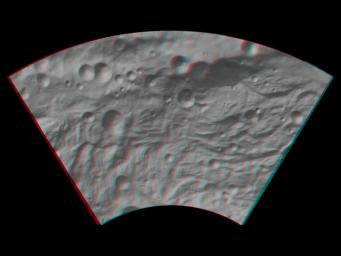
|
Anaglyph Image of Vesta’s Southwestern Latitudes
- Click the image above for a larger view
- Full-Res JPEG (2000 x 1500) (148.7 kB)
- Full-Res TIFF (2000 x 1500) (9.0 MB)
Caption:
This anaglyph image shows the topography of Vesta's southwestern region. When viewed correctly this image shows a 3D view of Vesta's surface. This effect was achieved by superimposing two differently colored images with an offset to create depth. To view this image in 3D use red-green, or red-blue, glasses (left eye: red; right eye: green/blue). The depth effect/topography differences in this image were calculated from the shape model of Vesta. The large, heavily degraded subdued rimmed crater in the top right becomes clearer in this anaglyph image. The hummocky (e.g. wavy/undulating) textured terrain of Vesta's southern region is also clear throughout most of this image. Many hypotheses about the formation mechanism of this distinctive terrane are currently under investigation. This image has a resolution of about 300 meters per pixel.
Background Info:
The Dawn mission to Vesta and Ceres is managed by NASA's Jet Propulsion Laboratory, a division of the California Institute of Technology, Pasadena, Calif., for NASA's Science Mission Directorate, Washington. UCLA is responsible for overall Dawn mission science. The Dawn framing cameras were developed and built under the leadership of the Max Planck Institute for Solar System Research, Katlenburg-Lindau, Germany, with significant contributions by DLR German Aerospace Center, Institute of Planetary Research, Berlin, and in coordination with the Institute of Computer and Communication Network Engineering, Braunschweig. The Framing Camera project is funded by the Max Planck Society, DLR, and NASA/JPL.
More information about Dawn is online at http://www.nasa.gov/dawn and http://dawn.jpl.nasa.gov .
Cataloging Keywords:
| Name | Value | Additional Values |
|---|---|---|
| Target | 4 Vesta | |
| System | Main Belt | |
| Target Type | Asteroid | |
| Mission | Dawn | |
| Instrument Host | Dawn | |
| Host Type | Orbiter | |
| Instrument | Framing Camera (FC) | |
| Detector | ||
| Extra Keywords | Color, Crater | |
| Acquisition Date | ||
| Release Date | 2011-10-06 | |
| Date in Caption | ||
| Image Credit | NASA/JPL-Caltech/UCLA/MPS/DLR/IDA | |
| Source | photojournal.jpl.nasa.gov/catalog/PIA14826 | |
| Identifier | PIA14826 | |
